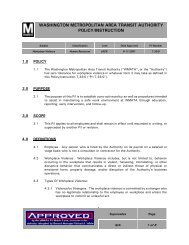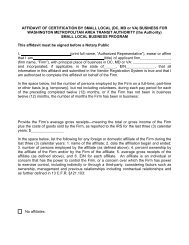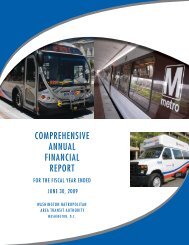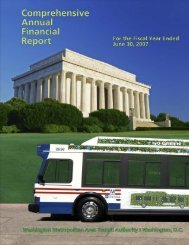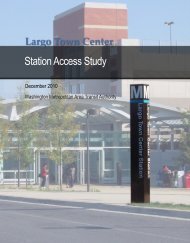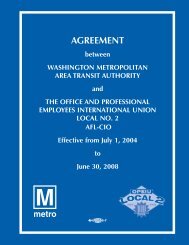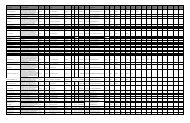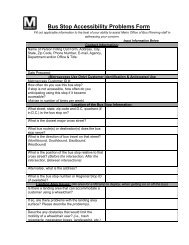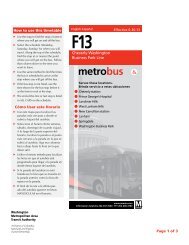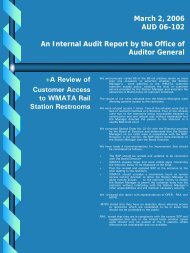Naylor Road Metro Station Area Access and Capacity - WMATA.com.
Naylor Road Metro Station Area Access and Capacity - WMATA.com.
Naylor Road Metro Station Area Access and Capacity - WMATA.com.
Create successful ePaper yourself
Turn your PDF publications into a flip-book with our unique Google optimized e-Paper software.
With the transformation of the <strong>Naylor</strong> <strong>Road</strong><br />
<strong>Station</strong> area from an automobile-oriented<br />
transit center to a regional center of mixed-use<br />
TOD, how people access the station will change<br />
by 2040 (Table ES-2). The model estimates that<br />
walk <strong>and</strong> bike access will grow significantly,<br />
owing to the expected concentration of<br />
mixed-use buildings at the station in the<br />
future. While the model estimates a decline in<br />
automobile access as a percent of daily mode<br />
share, Park & Ride usage will remain high.<br />
This study assumed that bus ridership will<br />
grow similarly to <strong>Naylor</strong> <strong>Road</strong> <strong>Station</strong>’s total entries (35 percent during peak periods <strong>and</strong> eight<br />
percent during off-peak periods) to ensure that adequate bus capacity is considered in future<br />
redevelopment. Finally, this study assumes that planning for up to three shuttle trips per hour<br />
during peak periods in 2040 is a reasonable, conservative assumption given the available data.<br />
Future <strong>Station</strong> <strong>Access</strong> Needs<br />
Realizing <strong>Naylor</strong> <strong>Road</strong> <strong>Station</strong>’s TOD vision will take years, <strong>and</strong> this redevelopment process is<br />
just now beginning through <strong>com</strong>pleted or in-process planning studies tasked with improving<br />
the station area <strong>and</strong> its multimodal access. This report uses information <strong>and</strong> findings from these<br />
studies as well as additional station observations <strong>and</strong> analyses performed specifically for this<br />
study to define station access deficiencies <strong>and</strong> opportunities for improvement—or more simply,<br />
station access “needs.”<br />
In addition, the study evaluated station capacity based on 2012 <strong>and</strong> estimated 2040 ridership<br />
levels. Table ES-3 shows that existing platform-to-mezzanine elevator capacity does not meet<br />
established st<strong>and</strong>ards, but that all other circulation<br />
elements at the existing mezzanine meet the minimum<br />
requirements for 2012 <strong>and</strong> estimated 2040 passenger loads.<br />
Circulation<br />
Element<br />
Existing<br />
This study also analyzed <strong>Naylor</strong> <strong>Road</strong> <strong>Station</strong>’s emergency<br />
egress capacity under existing conditions as well as<br />
estimated conditions in 2040 (Table ES-4). This analysis is<br />
based on the requirements set by the NFPA 130 st<strong>and</strong>ards.<br />
Evacuation time analysis is based on a worst-case-scenario<br />
with peak-direction trains containing twice the typical<br />
number of passengers to simulate a missed headway.<br />
<strong>Metro</strong> uses these guidelines as design goals when<br />
modifying station facilities to increase their emergency<br />
safety capabilities. The analysis results show that <strong>Naylor</strong><br />
<strong>Road</strong> <strong>Station</strong> presently does not meet emergency egress<br />
requirements for the afternoon peak period. However, as a<br />
result of shorter headways by 2040, the station is expected<br />
to meet all emergency egress st<strong>and</strong>ards in the future.<br />
Table ES-2: 2040 Estimated Weekday Mode Share for <strong>Naylor</strong><br />
<strong>Road</strong> <strong>Station</strong><br />
Period<br />
Park &<br />
Ride<br />
Kiss &<br />
Ride Bus<br />
Walk/<br />
Bike Total<br />
Weekday Mode Share Change from 2012 to 2040*<br />
Peak Periods -3% -49% 35% 39% 35%<br />
Off-Peak Periods 167% -75% 8% 294% 8%<br />
All day 12% -56% 30% 92% 27%<br />
Weekday Mode Share<br />
2012 23% 12% 46% 19% 100%<br />
2040 20% 4% 47% 29% 100%<br />
* Rounded to the nearest whole number<br />
Table ES-3: <strong>Station</strong> <strong>Capacity</strong> Analysis Results<br />
Elements Required<br />
2012 2040<br />
Platform Escalators 2 2 2<br />
Platform Elevators* 1 2 2<br />
Faregate Aisles 4 2 2<br />
Farecard Vendors 7 1 1<br />
* While only one platform elevator per mezzanine is required<br />
for ADA <strong>com</strong>pliance, current practice by <strong>Metro</strong> is to provide two<br />
platform elevators per mezzanine.<br />
Table ES-4: Future Emergency Egress<br />
NFPA<br />
Measure (minutes)<br />
Morning Peak<br />
Time to clear platform<br />
St<strong>and</strong>ard<br />
4.0<br />
2012<br />
3.6<br />
2040<br />
2.5<br />
Time to point of safety 6.0 5.1 4.0<br />
Afternoon Peak<br />
Time to clear platform 4.0 5.2 3.4<br />
Time to point of safety 6.0 6.7 4.9<br />
ES-5 | Executive Summary





